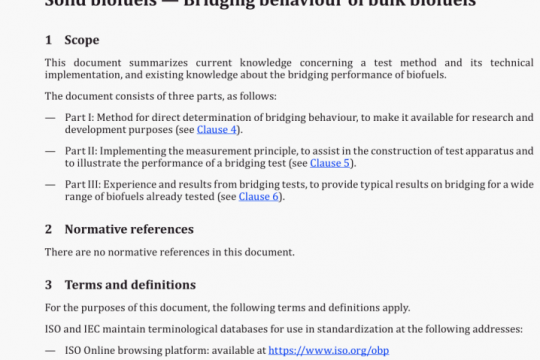ISO 22841 pdf free download
ISO 22841-2021 pdf free download.Composites and reinforcements fibres – Carbon fibre reinforced plastics(CFRPs) and metal assemblies 一Determination of the tensile lap- shear strength.
This document specifies a method for determining the lap-shear strength of the adhesive joint between carbon fibre-reinforced plastics (CFRPs) and metal adherends, using a standard specimen loaded in tension and under specified conditions of preparation, conditioning and testing. This method is intended for assessing the suitability of adhesives to be used for bonding a carbon fibre reinforced plastic (CFRPs) to a metal.
2 Normative references
The following documents are referred to in the text in such a way that some or all of their content constitutes requirements of this document. For dated references, only the edition cited applies. For undated references, the latest edition of the referenced document (including any amendments) applies.
ISO 291, Plastics — Standard atmospheres for conditioning and testing
ISO 472, Plastics — Vocabulary
3 Term and definitions
For the purposes of this document, the terms and definitions given in ISO 472 apply.
ISO and IEC maintain terminological databases for use in standardization at the following addresses:
— ISO Online browsing platform: available at littps://wwwd..orgJobp
— I EC Electroped ia: available at http://www.electropedia.org]
4 Principle
Adhesive lap-shear bond strength is determined by stressing a single-overlap joint between a CFRP and a metal adherend in shear by the application of a tensile force parallel to the bond area along the major axis of the specimen.
NOTE Single-lap specimens are economical, practical and easy to make. They are the most widely used specimens for development, evaluation and comparative studies involving adhesives and bonded products, including manufacturing quality control.
5 Apparatus
5.1 Linear measuring device. sucn as vernier caiipers or micrometre, capanie or measuring tne wiutn and thickness of the specimen with an accuracy of at least 0,05 mm.
5.2 Tensile-testing machine, selected so that the rupture of the specimen occurs between 10 % and
80 % of the full-scale capacity of the load cell. The response time of the machine shall be short enough so as to enable the force applied at the time of rupture to be measured accurately. The recorded force shall not differ from the true applied force by more than 1 %. The machine shall be capable of maintaining the constant speeds of testing specified in Clause 10. A machine which allows a constant rate of load application may be used. The machine shall he provided with a suitable pair of grips to hold the specimen. The grips and attachments shall be constructed so that they move into alignment with the specimen as soon as the load Is applied, so that the long axis of the specimen will coincide with the direction of the applied force through the centreline of the grip assembly.
6 Test specimen specification
The test specimen shall be constructed from two adherends: one CFRP and one metallic. It shall conform to the form and dimensions shown in Figures 1 and 2. Six test specimens shall be cut from test panels prepared as described in this clause and C.Iaue1. Arrows labelled b need to be aligned with narrowed cuts.ISO 22841 pdf download.




